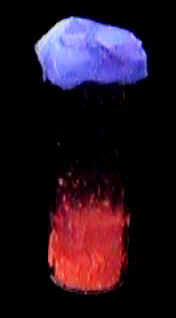Photons on Demand

Laser physicists are good at producing and manipulating single photons, but as with good comedy, the timing is important. Even the best experiments in quantum cryptography and computing–applications that make use of single photon properties–use sources that emit photons at random times. In the 4 October PRL a French team demonstrates a system that emits single photons on a dependable schedule at a frequency of 3 MHz. One other “triggered” photon source which operates on completely different principles was reported earlier this year. With these new techniques, researchers know exactly when and where a single photon will be found, and they are a step closer to quantum applications, such as cryptography that allows the receiver of information to deduce whether a message has been intercepted.
Imagine a photon counter in front of a very weak laser beam. The number of photons reaching the detector in a given period of time (the laser power) may be precisely known, but the photons will arrive at random times. Even a pulsed laser can’t be rigged to produce single photons on a schedule. To generate photons at specific times, Michel Orrit of the French National Center for Scientific Research (CNRS) in Talence and his colleagues used the fact that a dye molecule will dependably emit a single photon within a matter of nanoseconds every time it’s raised to the right energy level, and they excited such a molecule in a controlled and repeatable way.
From previous work, the team had learned that with a dilute solution of a dye chilled to 4 K they could target a single molecule using a well-focused laser beam. For their latest experiments, Orrit and his colleagues simultaneously applied a variable electric field across the frozen sample, which allowed them to slightly alter the frequency of light needed to excite the dye molecules. With the sample continuously illuminated by an excitation laser, the team applied an oscillating electric field at a frequency of 3 MHz, so that the dye molecule was excited twice per cycle–at the moments in time when the laser frequency matched the molecule’s resonant frequency. Ideally, this clock-like process would cause the molecule to flash a fluorescence photon with each excitation, but the system was not perfectly efficient.
To collect the photons, the tiny sample was surrounded by a small, dish-shaped (paraboloid) reflector. The team could not dependably detect every photon, so they verified the timing by measuring eight minutes worth of the signal and showing that the light arrived with the expected distribution in time–the majority arriving within a few nanoseconds of the schedule. The researchers also used a beam splitter and a pair of photon detectors to show that 74% of the time exactly one photon was emitted.
Orrit says that more than 95% efficiency should be possible with more expensive equipment, but his goal was to show that this relatively simple set-up is “a handy way of delivering single photons,” which quantum cryptographers will need in the future. “It’s very convincing,” says Alain Aspect of the CNRS in Orsay. He is impressed with the team’s control of single photons and with the cleverness of the experiment. He says this new system–as well as the other method for triggering single photons, reported earlier this year–will be important steps in the development of quantum cryptography.


